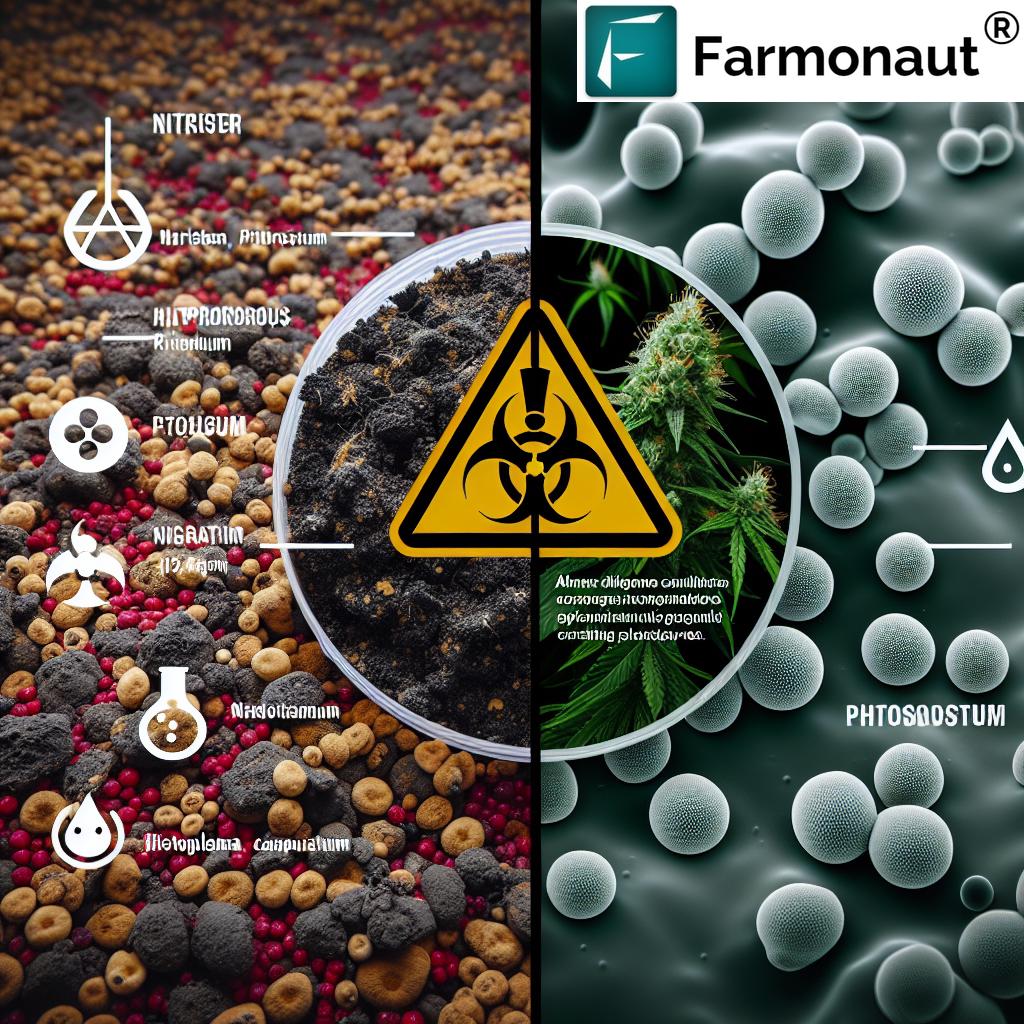Amending Soil for Tomatoes: Tackle Black Spot, Rot, Aphids & Boost Yields Sustainably in 2025
Meta Description: Amending soil for tomatoes improves yield and health in 2025. Discover eco-friendly control tips for black spot, rot, aphids, and blight on tomatoes.
“Tomatoes grown in amended soil can yield up to 30% more fruit while reducing black spot incidence by 40% sustainably.”
Table of Contents
- Tomato Cultivation: Why Careful Soil Amendment & Eco-Friendly Management Matter in 2025
- Amending Soil for Tomatoes: Building a Foundation for Health, Yield, & Resilience
- Latest Innovations in Soil Amendments
- Black Spot in Tomatoes & Black Rot on Tomatoes: Causes, Impact & Sustainable Solutions
- Aphids on My Tomatoes: Pest Management Approaches for 2025
- Blight on Tomatoes: Evolving Threats & Integrated Control Strategies
- Comparative Soil Amendment and Eco-Friendly Pest Solution Table
- How Farmonaut Empowers Sustainable Tomato Cultivation & Decision-Making
- Conclusion: Building a Resilient, Profitable, & Sustainable Tomato Crop in 2025
- Frequently Asked Questions (FAQ) – Tomato Soil, Pest, & Disease Management
Tomato Cultivation: Why Careful Soil Amendment & Eco-Friendly Management Matter in 2025
Tomato cultivation remains one of the most popular agricultural endeavors globally, favored by both commercial farmers and home gardeners alike due to the crop’s versatility, economic value, and culinary appeal. However, maintaining a robust, healthy, and highly productive tomato yield in 2025 requires more than just routine planting and watering—it calls for advanced knowledge in amending soil for tomatoes and the ability to manage disease and pest threats sustainably.
With evolving climate conditions and the advent of next-generation agritech solutions, the importance of sustainable soil management, targeted disease control, and eco-friendly pest solutions has been further emphasized. Addressing issues such as black spot in tomatoes, black rot on tomatoes, blight on tomatoes, and aphids on my tomatoes is not only essential for safeguarding crop health but also for supporting resilient and sustainable agriculture.
This comprehensive guide explores the best practices, amendments, and technological advances that are reshaping how we grow and protect tomatoes in 2025 and beyond.
Amending Soil for Tomatoes: Building a Foundation for Health, Yield, & Resilience
Amending soil for tomatoes is the crucial first step in ensuring a healthy, resilient, and high-yielding crop. Tomatoes thrive best in fertile, well-drained soils with a slightly acidic to neutral pH (around 6.0 to 7.0).
The right amendments enhance nutrient availability, water retention, and root development—all of which are vital for strong plants capable of withstanding pests and diseases.
The Role of Organic Matter
- Compost: Incorporating compost not only enriches the soil with essential nutrients (such as nitrogen, phosphorus, potassium, and micronutrients) but also adds beneficial microorganisms that help suppress tomato pathogens.
- Well-Rotted Manure: Adds valuable organic matter, improving soil structure, aeration, and water retention, especially during dry spells.
- Biochar: Biochar has gained traction as a soil enhancer in 2025. It acts as a sponge for nutrient retention while providing a habitat for beneficial soil microbes.
Improving Soil for Tomatoes: Core Steps
- Soil Testing: Advances in soil testing technologies now allow us to precisely tailor soil amendment plans—optimizing pH, identifying deficiencies, and tracking organic matter levels seasonally.
- Crop Rotation: Rotating tomatoes with cover crops (clover, vetch) helps fix nitrogen naturally, break pest and disease cycles, and support long-term soil health.
- Avoid Over-Tilling: Excess tillage breaks down soil structure and depletes organic content. Minimize tillage to preserve beneficial fungi and bacteria.
- Mulching: Using organic mulch conserves moisture, suppresses weeds, and regulates soil temperature.
By focusing on amending soil for tomatoes with these sustainable practices, we set the stage for productive, disease-resistant plants that better withstand evolving climate conditions and threats.
For those seeking to integrate advanced soil monitoring and precision agriculture tools, Farmonaut provides satellite-driven insights via API services and developer documentation. These solutions empower real-time decision-making and tailored soil management.
Latest Innovations in Amending Soil for Tomatoes: 2025 & Beyond
The landscape of soil health is evolving swiftly. In 2025, organic amendments remain crucial, but scientists and agronomists have introduced novel solutions that offer new avenues in sustainable tomato cultivation.
Trending Soil Enhancements for Tomato Crops
- Biochar: Sequesters carbon, increases cation exchange capacity (great for nutrient retention), and reduces greenhouse gas emissions from soil.
- Microbe Inoculants: Custom blends of beneficial bacteria and mycorrhizal fungi improve nutrient uptake and boost tomato plant disease resistance.
- Smart Soil Sensors: Linked with satellite monitoring platforms (such as Farmonaut), these sensors help track moisture, pH, and nutrient fluctuations in real time for targeted application of amendments.
- Blockchain-based Traceability: For those interested in documenting best practices, Farmonaut Product Traceability services ensure transparent records of soil amendment history and input authenticity, boosting consumer trust and export value.
Cover Crops & Their Role in Tomato Soil Health
Integrating cover crops continues to be an effective strategy for sustainable soil health in tomato fields. Clover and vetch are especially useful—they not only provide ground cover that prevents erosion and suppresses weeds, but also help fix atmospheric nitrogen and promote biological diversity in the rhizosphere.
Key Takeaway: A layered approach combining organic matter, biochar, targeted micronutrients, and rotational cover cropping elevates tomato soil health to new, sustainable heights.
Black Spot in Tomatoes & Black Rot on Tomatoes: Causes, Impact & Sustainable Solutions
Black spot in tomatoes and black rot on tomatoes are among the most common threats encountered by tomato growers. Both are fungal diseases, but present and behave differently—and demand integrated management approaches.
What Is Black Spot in Tomatoes?
- Caused primarily by Alternaria species.
- Symptoms: Small, dark lesions on leaves (sometimes stems and fruit), often with a yellow halo. Lesions enlarge under prolonged humid conditions, causing premature leaf drop and reduced plant health.
- Pathogen persists on crop debris and soil, especially in warm, humid environments.
What Is Black Rot on Tomatoes?
- Mainly caused by fungal pathogens like Colletotrichum spp., sometimes Alternaria.
- Symptoms: Sunken, black lesions on tomato fruits, starting small but expanding rapidly. Fruits often become unmarketable due to the unsightly rot and risk of secondary invasion by opportunistic fungi and bacteria.
- Prolonged moisture and poor air circulation increase black rot outbreaks.
Best Management Practices: Black Spot & Rot on Tomatoes
- Amending Soil for Tomatoes: Boost organic matter levels—healthy soils host more beneficial microbes that outcompete fungal pathogens.
- Crop Rotation: Avoid planting tomatoes in the same spot year after year; rotate with non-solanaceous crops to break disease cycles.
- Sanitation: Remove and destroy infected plant debris post-harvest to reduce pathogen carryover.
- Spacing and Pruning: Allow good air circulation by spacing plants adequately and pruning lower leaves to reduce periods of leaf wetness—fungal spores need moisture to germinate.
- Fungicides: Apply copper-based or systemic fungicides judiciously, rotating products to prevent resistance. Prioritize organic options first whenever possible.
- Mulching: Mulch suppresses soil splash of fungal spores onto lower tomato leaves, reducing initial infection points.
- Resistant Varieties: Planting fungal disease-resistant tomato varieties is a powerful long-term strategy as breeders introduce more options in 2025.
“Eco-friendly soil amendments can decrease aphid infestations in tomato crops by nearly 50% compared to conventional methods.”
Aphids on My Tomatoes: Pest Management Approaches for 2025
Aphids on my tomatoes are a familiar but persistent foe—especially in eco-friendly and organic tomato production. These sap-sucking insects thrive in warm, protected environments, often building up dangerous populations on new growth, stems, and the undersides of leaves.
Aphids: Why Are They Such a Risk?
- Feeding Damage: Causes leaf curling, yellowing, stunted growth, and reduced photosynthetic capacity.
- Viral Disease Transmission: Aphids can vector multiple tomato viruses, further compounding their impact.
- Sooty Mold: Honeydew excreted by aphids promotes black sooty mold growth on tomato plant surfaces.
Integrated Aphid Management Strategies for Tomatoes
- Biological Control: Encourage and protect beneficial insects (lady beetles, lacewings, parasitic wasps) in your tomato garden, which naturally prey on aphids.
- Insecticidal Soaps: Use organic insecticidal soaps to target clusters of aphids—safe for beneficial insects and pollinators when used correctly.
- Neem-Based Sprays: Neem oil disrupts aphid feeding and reproduction; apply in early morning or late evening to avoid leaf burn.
- Regular Monitoring: Early detection is crucial—spot treating small populations prevents damaging outbreaks.
- Companion Planting: Interplanting tomatoes with marigolds, basil, or chives masks crop scent and repels aphids.
Leveraging these sustainable pest management strategies results in reduced aphid pressure and limits the need for chemical insecticides that can disrupt beneficial insect populations and cause environmental harm.
Related Farmonaut Offering: Environmental Impact Tracking
Farmonaut’s real-time carbon footprinting platform enables farmers to monitor the environmental impact of their soil amendments and pest management actions—helping to verify, document, and continuously improve sustainable practices.
Blight on Tomatoes: Evolving Threats & Integrated Control Strategies
Perhaps the most feared disease among tomato cultivators is blight on tomatoes. With climate conditions becoming warmer and wetter in many regions, blight can devastate entire crops in days—especially late blight caused by Phytophthora infestans.
How to Identify Blight on Tomatoes
- Leaf Symptoms: Large, dark, water-soaked spots on leaves, expanding rapidly with a pale green border and possible white fungal growth on undersides.
- Stem & Fruit Symptoms: Similar dark lesions on stems and fruits—often accompanied by sudden plant collapse in severe cases.
Best Practices for Managing Blight on Tomatoes
- Resistant Varieties: Always choose tomato cultivars bred for blight resistance; these are increasingly available in 2025.
- Crop Rotation: Rotate tomatoes and potatoes with unrelated crops every 2–3 years.
- Mulching & Drip Irrigation: Avoid wetting leaves—use drip irrigation and organic mulch to keep plant canopies dry.
- Prompt Removal: Remove and destroy infected plants/leaves immediately to limit pathogen spread.
- Sustainable Fungicide Use: In high-risk regions, apply modern, targeted fungicides as a last resort, alternating chemistries and always respecting organic product guidelines.
Advanced Tips For Sustainable Blight Management
- Monitor weather closely—Farmonaut’s Jeevn AI advisory and satellite monitoring provide early warnings for weather conditions favorable to blight outbreaks.
- Maximize canopy airflow via pruning and optimal plant spacing.
Sustainable, integrated approaches to amending soil for tomatoes and managing disease and pest threats remain the cornerstone of productive tomato cultivation in 2025 and beyond.
Comparative Soil Amendment and Eco-Friendly Pest Solution Table
| Soil Issue or Pest | Recommended Amendment/Solution | How It Works | Estimated Yield Boost (%) | Eco-Friendliness Rating (1-5) |
|---|---|---|---|---|
| Poor Soil Structure | Compost, Well-rotted Manure, Biochar | Enriches soil, boosts water & nutrient retention, supports microbes | 10–30% | 5 |
| Low Nitrogen | Cover Crops (Clover, Vetch) | Naturally fixes nitrogen, reduces need for synthetic fertilizer | 8–20% | 5 |
| Black Spot in Tomatoes | Crop Rotation, Mulching, Copper-Based Fungicide | Reduces fungal pathogen survival and spread | 8–16% | 4 |
| Black Rot on Tomatoes | Sanitation, Resistant Varieties, Proper Irrigation | Limits fruit infection and postharvest loss | 8–15% | 5 |
| Aphids on Tomatoes | Biological Control, Neem Oil, Insecticidal Soaps | Suppresses pest populations, preserves beneficials | 5–12% | 5 |
| Blight on Tomatoes | Resistant Varieties, Mulch, Smart Fungicide Rotation | Minimizes crop devastation, preserves yield | 10–25% | 4 |
How Farmonaut Empowers Sustainable Tomato Cultivation & Decision-Making
As agriculture in 2025 moves toward data-driven, sustainable practices, we at Farmonaut are committed to empowering farmers, agronomists, and agri-entrepreneurs with advanced, accessible satellite-based monitoring and advisory tools. Our platform leverages multispectral satellite imagery, AI analytics, and blockchain traceability to deliver actionable, real-time insights into tomato crop health, soil nutrient dynamics, moisture patterns, and disease/pest risk factors—supporting smarter, more resilient farming decisions.
- Real-Time Crop Monitoring: Satellite NDVI maps help identify underperforming zones in tomato fields, which may signal nutrient deficiencies or early signs of black spot or blight.
- Jeevn AI Advisory System: Our AI engine interprets complex data to advise on the optimal timing and placement of soil amendments, watering, and pest management.
- Blockchain-Based Traceability: With Farmonaut’s product traceability, farmers can document and verify the use of sustainable soil amendments and eco-friendly pest solutions—boosting market confidence and meeting export traceability requirements. Learn more.
- Resource Optimization: Utilize fleet and resource management solutions to track machinery and labor use, reducing operating costs while supporting eco-friendly interventions. Explore our fleet management features.
- Risk Management for Financing: Our crop loan and insurance tools employ satellite-based verification for faster, fraud-resistant lending/insurance in tomato and other crop systems.
By integrating Farmonaut’s solutions, farmers and agri-businesses can monitor, record, and optimize soil amendments and pest/disease management strategies effectively—driving profitability, sustainability, and transparency even under challenging, evolving agricultural conditions.
For those managing large commercial tomato farms or coordinated grower networks, discover Farmonaut’s large scale farm management suite for crop health mapping, resource allocation, and strategic intervention.
Conclusion: Building a Resilient, Profitable, & Sustainable Tomato Crop in 2025
As we look ahead to the demands and opportunities of 2025, amending soil for tomatoes with organic matter, innovative amendments, and targeted nutrition forms the foundation of sustainable success. Fighting black spot, black rot, aphids, and blight on tomatoes requires vigilance, science-driven integrated management strategies, and a willingness to adopt modern technologies.
The fusion of eco-friendly amendments, biological control, rotational planting, and AI-powered decision support systems (like those from Farmonaut) is redefining how farmers and gardeners protect their crops while promoting soil health and minimizing environmental impact.
In summary, ensuring healthy, productive tomatoes in 2025 is about harmonizing tradition and innovation—prioritizing sustainability amid changing climate conditions and consumer demands.
Frequently Asked Questions (FAQ) – Tomato Soil, Pest, & Disease Management
Q1. What’s the most important first step in amending soil for tomatoes?
A: Begin with a comprehensive soil test to assess pH, nutrient levels, and organic content. Use the results to guide the type and quantity of organic amendments (compost, manure, biochar) for optimal tomato health.
Q2. How can I organically manage black spot in tomatoes and black rot on tomatoes?
A: Rotate crops, enrich the soil with compost, use resistant tomato varieties, mulch to suppress soil splash, and apply copper-based or organic fungicides as needed. Remove affected leaves and fruit immediately to prevent spread.
Q3. Which cover crops are best for improving nitrogen in soils for tomatoes?
A: Clover and vetch are excellent options as they naturally fix atmospheric nitrogen, reduce erosion, and break pest and disease cycles.
Q4. What are the best sustainable pest management solutions for aphids on tomatoes?
A: Encourage natural predators (lady beetles, lacewings), use neem oil or insecticidal soap, and regularly inspect plants for early aphid populations. Limit use of broad-spectrum insecticides to protect beneficial insects.
Q5. Can digital tools help optimize soil amendment and pest/disease control for tomatoes?
A: Absolutely! Platforms like Farmonaut use satellite, AI, and IoT technologies to monitor crop and soil conditions, predict pest/disease risk, and support efficient, sustainable management decisions.
Ready to transform your tomato yields with cutting-edge, sustainable solutions? Start with the right soil amendment, eco-friendly pest management, and data-driven tools for a thriving crop in 2025 and beyond.













